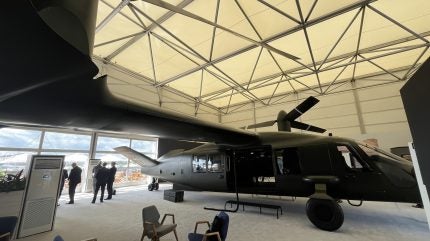
Bell leads the Future Long-Range Assault Aircraft (FLRAA) programme.
In an interview, Frank Lazzara, Director of Advanced Vertical Lift Systems Sales and Strategy at Bell, revealed developments and plans for the programme.
The FLRAA programme’s timeline has already seen Lockheed Martin’s Sikorsky and its partner Boeing filing a formal protest against the US Army’s decision to award the Future Long-Range Assault Aircraft (FLRAA) contract to Bell Textron’s V-280 Valor.
However, the US Government Accountability Office (GAO) denied the protest in April 2023. The FLRAA programme, aiming to replace the ageing UH-60 Black Hawk by 2030, chose the V-280 Valor over Sikorsky’s SB>1 Defiant X, securing a contract valued at approximately $7.1bn.
Collaboration at the forefront
Bell’s collaboration with the US Army has been vital in the FLRAA programme’s development. Lazzara emphasised the integration of efforts, stating, “The collaboration started long before we were on this contract back during the Joint Multi-Role Technology Demonstrator phase. It was essential to showcase our capabilities as a reliable partner for a future programme.
Now, under a formal contract, we’re operating in a shared digital environment with the Army, facilitating an open exchange of information. Everybody’s in the same environment, looking at the same data, evaluating it, making suggestions. The collaboration has gone exceptionally well, with the digital framework being a significant factor.”
Performance metrics
The FLRAA programme aims to surpass the capabilities of existing military aircraft. While specific numbers remain classified, Lazzara noted, “From a speed range perspective, [V-280 Valor is] more than twice as fast and will have twice the range of a modern Blackhawk helicopter.” The demonstrator aircraft, the V-280 Valor, has already showcased capabilities, including achieving 305 knots of true airspeed.
FLRAA is designed for various missions, from long-range assaults to humanitarian assistance. Lazzara highlighted its potential, particularly in disaster relief, citing past successes with the V-22 Osprey. “The V-22 has really shined in Japan, Haiti, numerous other places around the world. The response time from the initial catastrophe or disaster is greatly shortened by tilt rotor.”
For medevac missions, the FLRAA’s speed and range are game-changers. “Being able to go to the point of injury or near point of injury and then being able to fly them directly to a higher level of care. The difference is really immeasurable.”
The US’s procurement programmes, such as the UH-60 Black Hawk and Future Long Range Assault Aircraft (FLRAA), drive major investment in the transport and utility helicopter segment, according to “The Global Military Rotorcraft Market 2023-2033” report.
Testing and milestones
While the actual FLRAA aircraft is yet to be built, the V-280 Valor has laid a foundation. “We demonstrated 305 knots flight, cruising at 11,000 feet, and we demonstrated a basic autonomous flight. It was pretty successful – we have recorded about 215 flight hours,” Lazzara recounted. This successful demonstration phase has reduced technological risk, paving the way for the FLRAA’s future development.
Leveraging past experience
Bell’s history with tilt-rotor technology, particularly the V-22, has been invaluable. “We were not on our first iteration of trying to prove out a technology. There were definitely lessons learned as we applied that aircraft, that gave us a huge leg up, just from a risk reduction perspective.”
This accumulated knowledge has informed the FLRAA’s design, ensuring it meets the requirements of modern military operations while avoiding past pitfalls.
Supporting the transition
Bell is committed to providing support as the US Army prepares to transition to the FLRAA platform. “We have agreed to provide a lot of intellectual property along with this design, showing training that answers the question of how will you train aircrew and maintainers to have an operational capability at their initial stand-up.”
CAE has partnered with Bell Textron Inc. to support the US Army’s Future Long Range Assault Aircraft (FLRAA) programme by providing training aids, simulators, and simulations for the Bell V-280 Valor. GE Aerospace was also selected to develop a Common Open Architecture Digital Backbone for the V-280.
Global potential and future prospects
Looking beyond the US Army, the FLRAA has the potential to be adopted by allied forces. “We’ve been out there communicating with our key security cooperation partners, especially the UK… The modular, open systems approach, I think, will be a big multiplier.”
The groundwork has been laid while formal licensing for international sales is pending. “If we execute, then our key security cooperation partners will take note and say, ‘Okay, this is going to happen, and it is going to be within our cost objectives.'”
Frank Lazzara’s insights paint a picture for the FLRAA programme. As highlighted, the collaboration, technological advancements, and operational benefits of the FLRAA will enhance US Army operations and attract global interest.





